Editors’s note: Click here to read the author’s MA thesis expanding on this topic.
On a chilly Sunday afternoon in March, our Field Campus group walked through downtown Granite City, Illinois. Located just 6 miles north of St. Louis, the downtown was a markedly post-industrial landscape. Many of the red brick buildings were vacant and showed signs of lasting decay. Weedy patches of open land occasionally provided views of a large nearby factory. It was hard to tell if coffee and sandwich shops were closed forever.
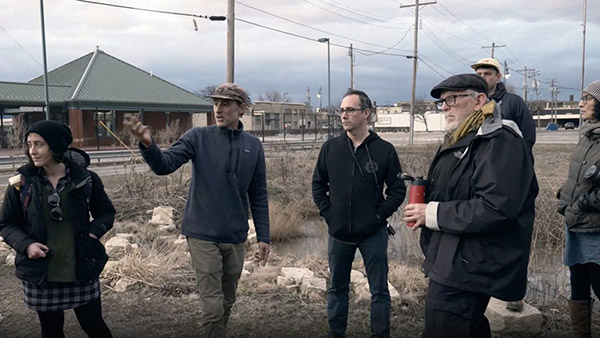
Chris Carl, Studio Land Arts Director at GCADD presents his “DIY lead garden” to field campus participants. Video still by Tim Schütz, March 2019.
The factory, a U.S. Steel Corps manufacturing plant called Granite City Works was founded by two German immigrants in 1896, along with the city itself. In 2009, the National Air Toxics Assessment (NATA) ranked neighborhoods in Granite City at the second highest risk for cancer in the country, highlighting the plant’s coke ovens as a likely source (McGuire 2009). Coke oven emissions include benzene, arsenic, and lead (Earthjustice 2019) – that people breathe, and soils absorb. Another source of toxic air pollution has been the NL Industries/Taracorp lead smelter. Before its closure in 1983, the smelter contaminated over 1,600 households in Granite City and beyond, eventually turning into an EPA superfund cleanup site (Singer, n.d.). The US EPA recognized that the highest concentrations of lead in the air are around smelters. Lead in the air means lead in the soil. Tearing down houses in “blighted” sections of the city exacerbates the problem since demolitions release the lead in the paint of older buildings (Blythe 2019). Granite City is certainly a hot spot.
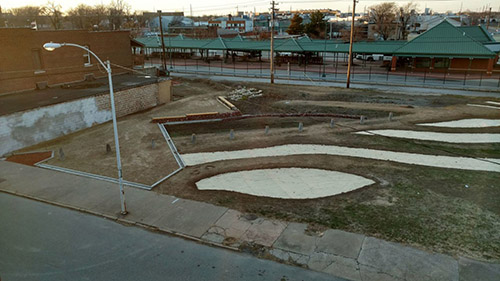
“Pilot plot” in Granite City under construction. Photo by New American Gardening, n.d.
As we walked through Granite City, we were guided by our local collaborator and artist Chris Carl, whose work with the urban renewal group New American Gardening “explores garden making on vacant lots and post industrial land.” Chris led us to the particular plot, pointing to a number of concrete blocks scattered around the ground. One of the blocks featured a warning symbol etched into its top, the other had the letters ‘Pb’ scrawled upon it – which, as he informed us, is the chemical abbreviation for lead. The blocks were Chris’s “DIY version of a lead remediation,” an intervention he began after a project by the College of Agricultural, Consumer, and Environmental Sciences and a visit by EPA officials who confirmed low levels of lead all over the area after conducting the requisite soil testing. The levels on the site we were standing on, however, had proven to be “off the charts.” Notably, both Madison County and the U.S. Steel Trust had provided funding for this pilot plot.
A Do-It-Yourself Lead Garden and Rogue Data
The idea behind “DIY” lead remediation is sobering. The technical and governing infrastructure needed to do lead remediation “right” is substantial. But if these infrastructures are unavailable, the work is thrown back to local figures like Chris Carl. The Quotidian Anthropocene project documents and engages with such individuals, learning from them what “the Anthropocence” looks like in everyday terms, thinking with them about ways academic researchers can be resources. My focus within the Quotidian Anthropocene project is on ways academic researchers and institutions can help build the kinds of data infrastructures needed going forward – stewarding places like Granite City.
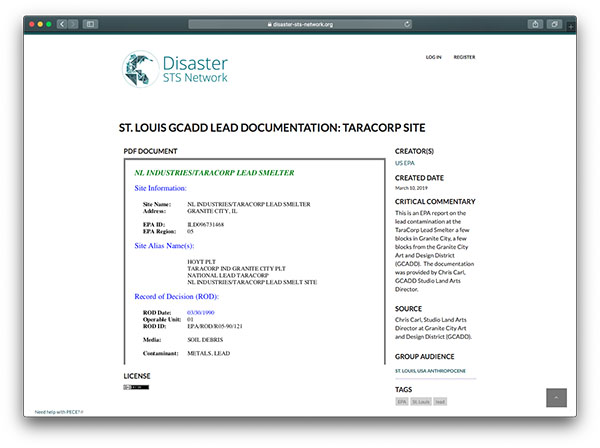
Finding a home for a rogue EPA report. Screenshot of Disaster STS Network by Tim Schütz, September 2019.
After our “lead garden” visit, we returned to the Granite City Art and Design District (G-CADD), Carl’s collective studio and exhibition space, where Carl showed us a 1990 EPA report he had downloaded from the official EPA website. Carl knew where to find the 1990 EPA report, and had saved a copy on his personal hard drive. We were interested in how reports like this – and documentation of the kind of “gardening” Carl had initiated – could be preserved in a more durable way: so that they are accessible and discoverable by diversely positioned social actors. Our contribution as academic researchers could potentially be here: helping build data infrastructure for the Anthropocene with situations like the one in Granite City in mind.
We know that data infrastructure for the Anthropocene will be complicated. It will need to respond to ways the Anthropocene is playing out in different places, working synergistically with government agencies while also aware of the many limits on government capacity. At worst, of course, governments “disappear” relevant data or configure it in ways that render it meaningless or useless (see the work of the Environmental Data Governance Initiative, EDGI – to counter the former).
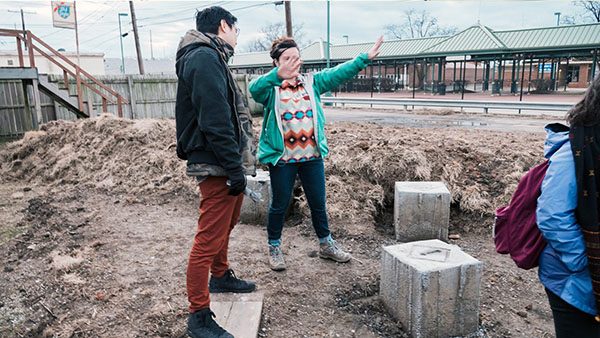
Field campus participants discussing the lead garden. Photo by Tim Schütz, March 2019.
By design, our Field Campuses therefore work to focus our attention on the politics of environmental data. Our goal is not only to identify data incapacities but to design against them through experimental archiving practices that link communities to academics in new ways. We’re doing this work – what we’re calling Archiving for the Anthropocene – on the digital platform supporting the Disaster-STS network, an instance of the Platform for Experimental Collaborative Ethnography (PECE), currently housed at the University of California, Irvine, but led by a transnational design team. Through this work, we aspire to build new social relations, modes of collaborative knowledge production, and ways of using environmental data for the public good. We wanted to build on Carl’s practice of “rogue archiving” (De Kosnik 2016) by uploading and annotating the EPA report he was working with on the Disaster-STS network.
Archiving for the Anthropocene
The Quotidian Anthropocene project is a direct response to this need to address the nested nature and data intensity of complex, accelerating environmental problems. Exploring “how the Anthropocene is playing out on the ground in different settings” and “to create both situated, place-based and comparative perspective, building new modes of collective knowledge and action” (Ludwig et al 2019), the Field Campus has addressed toxic legacies of the US military-industrial complex and the petrochemical industry. In St. Louis, for instance, intensely toxic lead levels are coupled with other registers of toxicities: oil refineries, mounds of nuclear waste, as well as enduring racial inequalities (Gordon 2019, see also the book’s interactive website). During our September 2019 Field Campus in New Orleans, we found racial power dynamics endure, where hundreds of chemical plants in Louisiana’s “cancer alley” have been built on the grounds of former slave plantations (Laughland and Lartey 2019). To enable comparison between various ‘anthropocenic’ sites, the Field Campus focuses on a set of twelve analytic scales and related questions, as well as distinct themes such as public lands and energy transition.
The theme essay on civic infrastructure offers researchers empirically oriented prompts that ask how (civic) technologies shape different anthropocenic locations. Further, the essay is an attempt to draw together and analyze existing ways for “informating” (Fortun 2004) the environment like the California EPA’s EnviroScreen or ProPublica’s Bombs in Your Backyard. The project’s own digital infrastructure – including open online seminar sessions, the Disaster STS digital workspace, email lists and WhatsApp groups are active experiments around a crucial double-bind: attempts to develop civic infrastructures that need to be locally attuned but also forge connections globally.
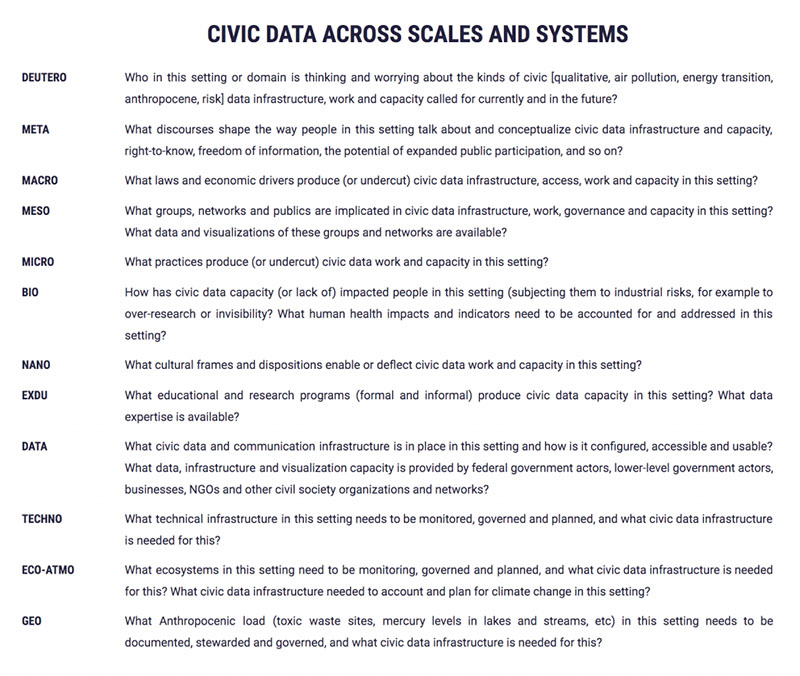
Analytical questions to query Civic Data across scales and systems. Open for comments in this collaborative Google Doc.
One of the ways in which we try to forge global connections is to coordinate our ethnographic and analytic efforts with groups in other countries. In parallel to our recent field campus in New Orleans, a group of Taiwanese STS scholars, who critically engage with incidents at a Formosa Chemicals plant in Kaohsiung (Tu 2019), also visited the compound of a Formosa plant under construction in Louisiana’s “cancer alley.” On the same day, our Field Campus became a node for their activities; while we collectively watched their co-produced documentary “The S Files: Petrochemical Regulatory Control in Taiwan.”
Future ethnographic experiments include Field Campuses in Ecuador, Portugal, Korea, and Taiwan. Each iteration will refine our analytic scales, relaying us into collaborative analysis in other places, helping us understand what “archiving for the Anthropocene” needs to become. We are learning from figures like Chris Carl about what needs to be done and is possible – and about ways academics can organize their practice and infrastructure to help. There are many experiments in play at once, with the persistent sense of urgency that the Anthropocene engenders. We welcome new collaborators. Get in touch if you want to join the work.
Acknowledgements
I want to thank Chris Carl and all participants in the Quotidian Anthropocene project. I also thank Andrew Schrock, Prerna Srigyan, Kim Fortun, Timothy Gitzen, and Nandita Badami for their comments, edits and support.
References
Blythe, B. (2019). “St. Louis demolitions bring renewed risk for lead poisoning.” St. Louis Post-Dispatch, January 7, 2019. Accessed October 1, 2019. https://www.stltoday.com/news/local/metro/st-louis-demolitions-bring-renewed-risk-for-lead-poisoning/article_e220afea-8a6d-5476-86fa-48eb695ab9b2.htm
De Kosnik, A. (2016). Rogue Archives. Digital Cultural Memory and Media Fandom Cambridge: MIT Press.
Earthjustice. (2019). Groups Sue Trump’s EPA for COke Oven Cancer Pollution. Earthjustice. Accessed October 1, 2019. https://earthjustice.org/news/press/2019/groups-sue-trump-s-epa-for-coke-oven-cancer-pollution
Fortun, K. (2004). From Bhopal to the informating of environmentalism: Risk communication in historical perspective. Osiris, 19, 283-296.
Gordon, C. (2019). Citizen Brown. Race, Democracy, and Inequality in the St. Louis Suburbs. Chicago: University Press.
Laughland, O. & Lartey, J. (2019). First slavery, then a chemical plant and cancer deaths: one town’s brutal history. The Guardian, May 6, 2019. Accessed October 1, 2019. https://www.theguardian.com/us-news/2019/may/06/cancertown-louisiana-reserve-history-slavery
Ludwig, J., Schütz, T., Knowles, S. G., and Fortun, K. (2019). Tactics for Quotidian Anthropocenes: A Field Campus Report. Anthropocene Curriculum. https://anthropocene-curriculum.org/contribution/tactics-for-quotidian-anthropocenes
McGuire, K. (2009). “Granite City ranks high for cancer risk from bad air 2nd in the nation • Coke ovens at U.S. Steel believed to be the culprit, but some defend plant.” St. Louis Post-Dispatch, June 25, 2009. Accessed October 1, 2019.
https://www.stltoday.com/news/granite-city-ranks-high-for-cancer-risk-from-bad-air/article_fcf2bde1-fee0-5db5-b635-5349b805acf8.html
Singer, B. (n.d). Nl Industries/Taracorp Lead Smelter. ToxicSites. Accessed October 1, 2019. http://www.toxicsites.us/site.php?epa_id=ILD096731468
Tu, W.-L. (2019). The Explosion of the Sixth Naphtha Cracker in Yunlin, Taiwan. How can we improve the governance dilemma of petrochemical industry? 4S Backchannels, June 11, 2019. Accessed October 1, 2019. https://www.4sonline.org/blog/post/the_explosion_of_the_sixth_naphtha_cracker_in_yunlin_taiwan._how_can_we_improve_the_governance_dilemma_of_petrochemical_industry
